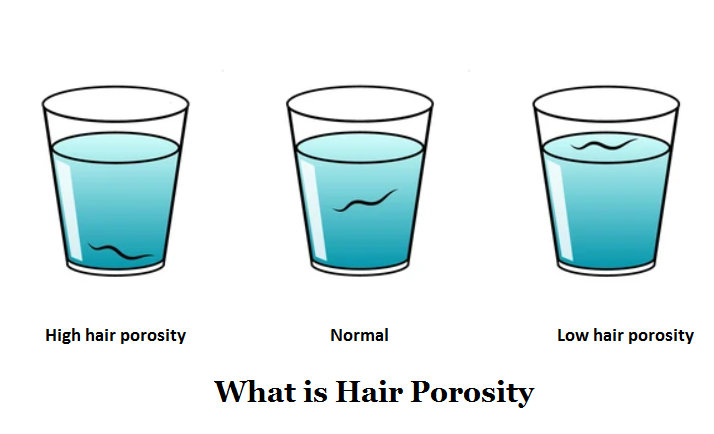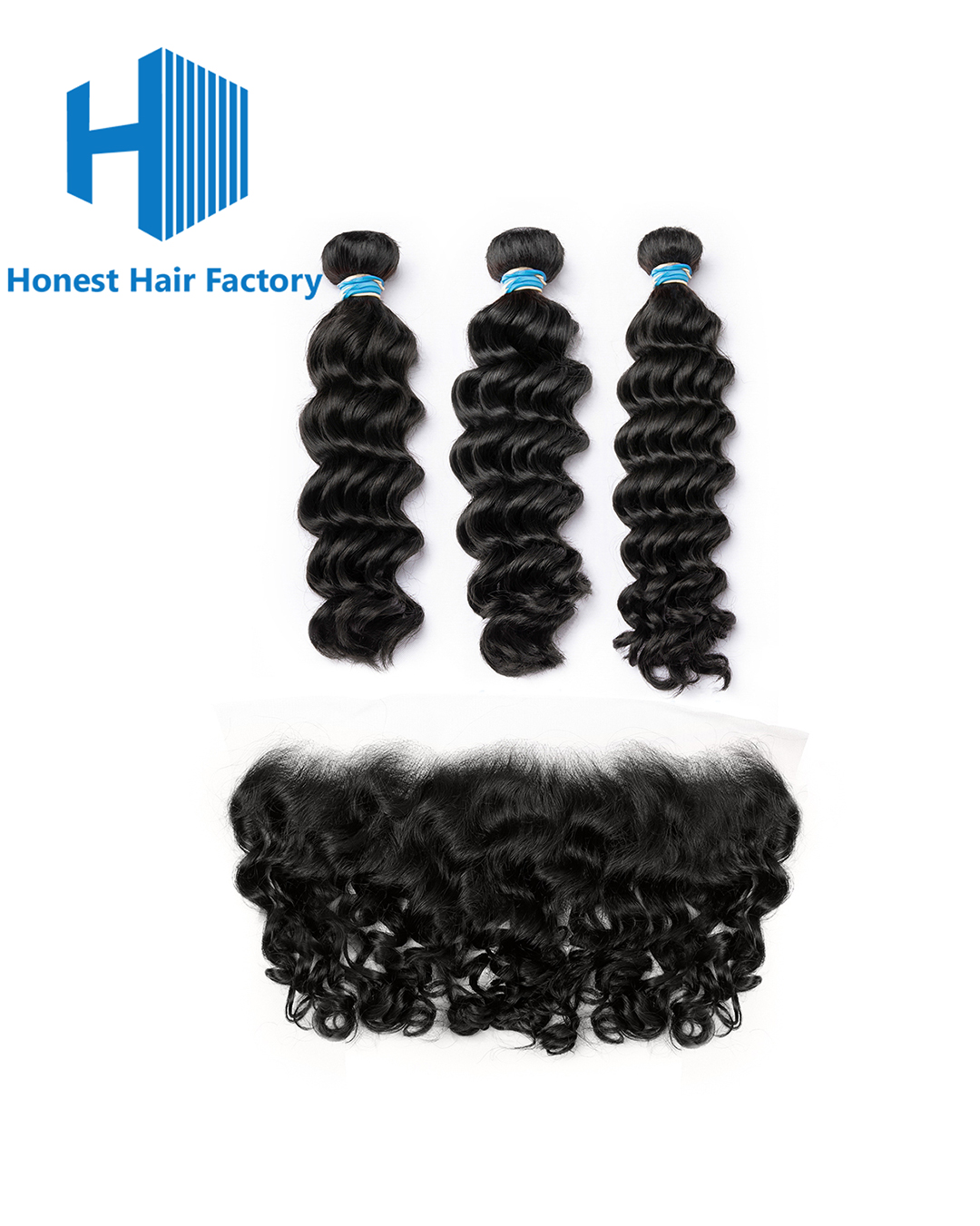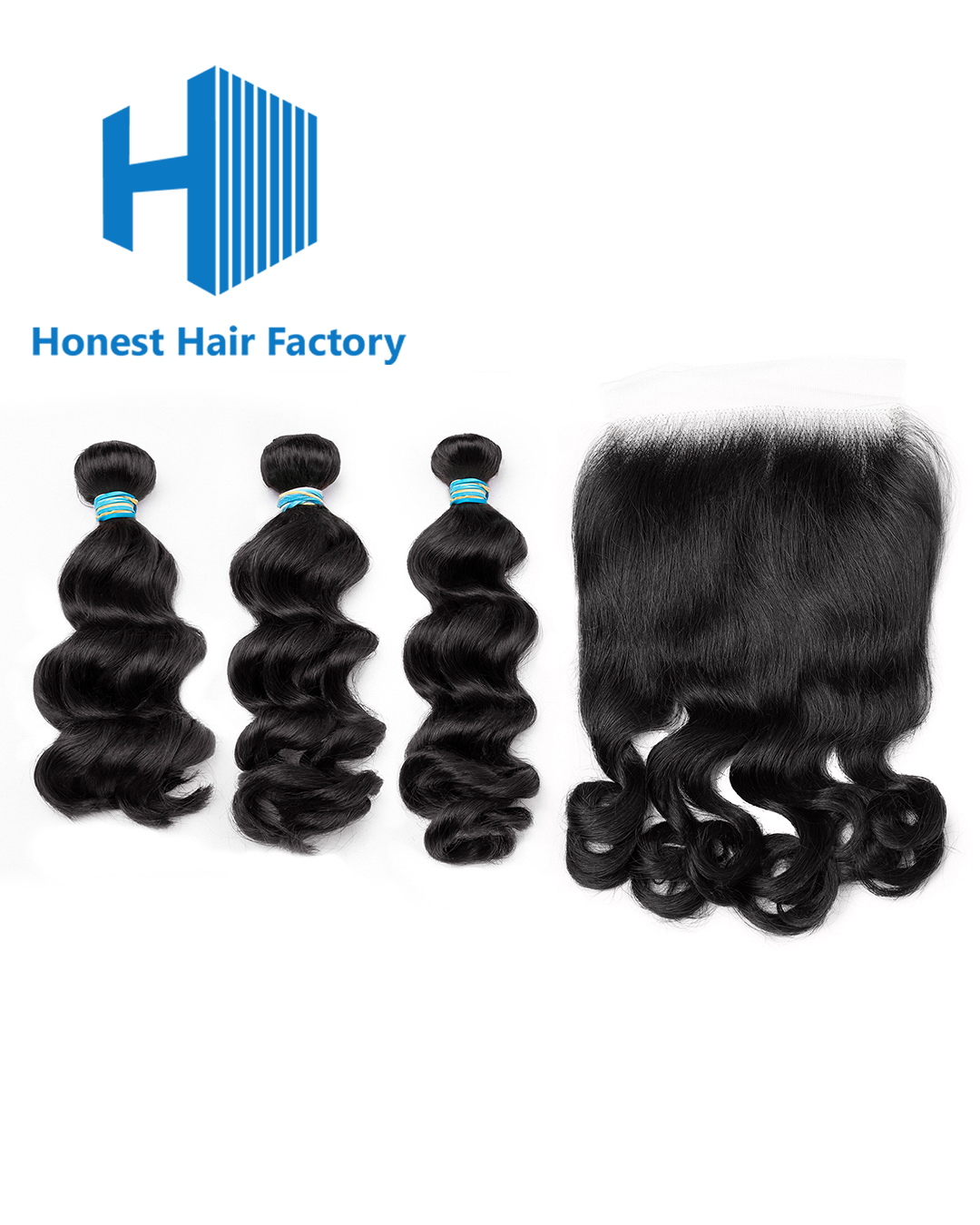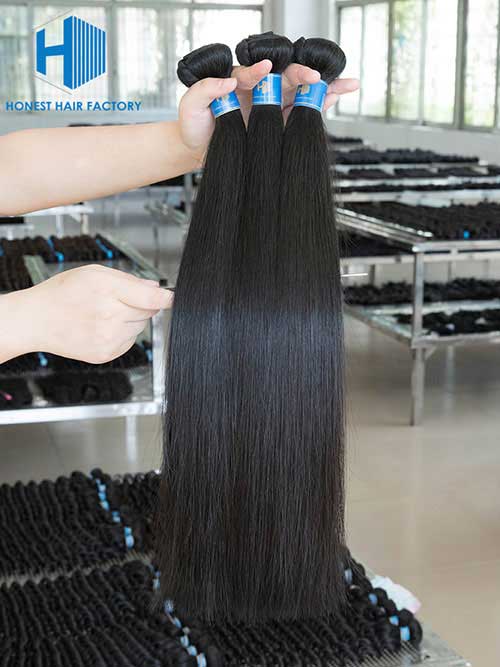These bundles are made from 100% virgin human hair, which is soft and easy to style. The HD lace frontal provides a natural hairline, making it a great option for achieving a seamless look while protecting your natural hair underneath.
What is Hair Porosity & Different Types of Hair Porosity - How to Test Hair Porosity
You may wonder why your hair takes so long to dry after washing and why it's not easy to absorb moisture. This may be related to hair porosity. What are the types of hair porosity, and how can you identify them? In this post, we will cover the definition of hair porosity, its types, hair porosity test methods, and how to tell the type for each test. We'll also break down the advantages, disadvantages, care, and suitable products for low, medium, and high porosity hair.

What is Hair Porosity?
Hair porosity refers to the ability to absorb and maintain moisture, which is influenced by the structure of the hair's outer layer, known as the cuticle. But it can also be influenced by external factors, including heat damage, chemical treatments and mechanical stress. Frequent use of heat styling tools can lift the cuticles, increasing porosity. Processes like bleaching or coloring can compromise the cuticle's integrity, leading to higher porosity. Daily grooming practices, such as brushing and washing, can also affect the cuticle and alter porosity over time. Normal hair can absorb water quite easily, and it contains water. There are also too low or too high hair porosity require different maintenance and products.
Different Types of Hair Porosity
There are three types of porosity levels: low, medium, and high.
Low Hair Porosity
Starting with low porosity, if you have low porosity hair that means that all the cuticles of your hair strands are extremely sealed and closed shut, so it's really hard to allow moisture to come in. It is difficult for hair to absorb new water, but low porosity hair also difficult to lose protein, low porosity hair is also known as protein-sensitive hair, so you will find that in this case, you need much less protein, because generally speaking, the healthiest hair is pretty much going to be low porosity. Typically with lower porosity, you're gonna need something that's a little bit more aggressive in order to get the job done just because it's so resistant.
Advantages:
Stronger and Healthier: Low porosity hair tends to be stronger and shinier because the cuticles lay flat, which helps protect the hair shaft.
Less Prone to Damage: This hair type is generally less susceptible to split ends and damage from environmental factors if not subjected to excessive heat styling.
Disadvantages:
Difficult to Moisturize: Low porosity hair struggles to absorb moisture and products, often leading to buildup on the hair surface.
Long Drying Time: It takes longer for low porosity hair to dry completely, which can be inconvenient.
How to Know If You Have Low Porosity Hair?
The first one of the signs to let you know if you have low porosity hair is products are really absorbed into your hair, they kind of just feel like they sit on your hair and you often get a lot of product build-up your hair does not absorb hair color very easy, takes a long time to actually change the color of your hair and to do any type of treatment, you might notice water beads on your hair when you leave your hair what you actually see the water droplets just sitting on your hair or it takes a very long time for your hair to get completely wet waiter in the shower. Another sign is that your hair takes hours to dry or if you use a lot of products that are like butter and it's just too thick and leaves your hair oily, it might be too much for your hair because of its low porosity.
How to Care for Low Porosity Hair?
Opt for water-based products that can penetrate the hair shaft more easily. Avoid heavy oils and creams that can lead to buildup.
Applying heat (like a warm towel or a hooded dryer) can help open the cuticles slightly, allowing for better product absorption.
Use a clarifying shampoo occasionally to remove product buildup, which can be a common issue for low porosity hair.
Washing too frequently can strip natural oils, so aim to wash your hair every few days instead of daily.
Medium (Normal) Hair Porosity
The cuticles are less tightly bound, allowing for a balanced absorption and retention of moisture. Hair with medium porosity typically styles well, holds color effectively, and appears healthy.
Advantages:
Balanced Moisture Retention: Medium porosity hair allows for good moisture absorption and retention, making it easier to maintain healthy hair.
Versatile Styling: This hair type styles easily and holds styles well, making it adaptable for various looks.
Disadvantages:
Potential for Damage: While medium porosity hair is generally healthy, it can become damaged over time due to heat styling or chemical treatments if not properly cared for.
How to Know If You Have Medium Porosity Hair?
Medium porosity hair absorbs moisture easily and retains it well, this hair type typically holds styles well and takes color effectively.Hair with medium porosity does not take too long to air dry, indicating a balanced moisture retention capability. Take a clean, product-free strand of hair and drop it into a glass of water. If the hair floats in the middle of the glass, it indicates medium porosity.
How to Care for Medium Porosity Hair?
Use a mix of moisturizing and protein-rich products to maintain the health of your hair. This balance helps prevent damage while keeping hair hydrated.
Incorporate deep conditioning treatments into your routine to keep hair soft and manageable. Aim for once a week or as needed.
While medium porosity hair is resilient, excessive heat styling or chemical treatments can lead to increased porosity. Be mindful of your styling practices.
Use clarifying shampoos to prevent product buildup, but not too frequently to avoid stripping moisture.
High Hair Porosity
On the contrary, high porosity is easy to absorb water, but it is also easy to lose water. For high porosity, you should focus on using sulfate-free substances. The reason is that these cuticles will naturally be more open. Using a more gentle cleaner will help keep the cuticle down. If you have high porosity, the cuticle is way more open, so it can absorb moisture really easily but it does not retain the moisture easy, high porosity hair is also referred to damaged or highly processed hair because the cuticles are damaged, so they are torn making them more open, you also might notice that your hair tangles extremely easy because all the cuticles are getting cut onto each other.
Advantages:
Quick Absorption: High porosity hair absorbs moisture and products quickly, which can be beneficial for hydration.
Fast Drying: This hair type dries quickly after washing, saving time in your hair care routine.
Disadvantages:
Poor Moisture Retention: High porosity hair struggles to hold onto moisture, leading to dryness and frizz.
Prone to Damage: It is more susceptible to breakage and damage due to the gaps in the cuticle layer, which can result from genetic factors or environmental stressors.
How to Know If You Have High Porosity Hair?
If you have high porosity hair, then your hair dries extremely fast, if you notice that your hair continuously always tends to get frizzy could be because of high porosity or if you use products like lotions and milk and they just don't work for you, might not be enough for your high porosity hair. High porosity hair actually likes protein, so if you can use products with protein or do a DIY wash using eggs, your hair will love it.
How to Care for High Porosity Hair?
Use products that are rich in moisture, such as creams and oils that contain heavier ingredients like shea butter or argan oil to help seal in moisture.
Regularly use deep conditioning masks to replenish moisture and repair damage. Aim for at least once a week.
Always apply a heat protectant before using heat styling tools to minimize further damage.
Consider using the LOC (Liquid, Oil, Cream) method to maximize moisture retention. Start with a water-based product, follow with an oil to seal in moisture, and finish with a cream for added hydration.
Best Products for High Porosity Hair 2025
For individuals with high porosity hair, selecting the right wigs, hair bundles, and hair care products is essential to maintain moisture and protect the hair.
Hair Bundles
High porosity hair has cuticles that are widely spaced or damaged, allowing moisture to enter and escape quickly. This can lead to dryness and frizz, making it challenging to maintain healthy hair. Wearing wigs or extensions can provide a protective barrier, helping to shield high porosity hair from environmental stressors, heat styling, and manipulation that can cause further damage.
2. Loose Wave Bundles with HD Closure
The loose wave bundles offer a beautiful, bouncy texture that is easy to manage. The included HD closure ensures a natural appearance and helps to minimize manipulation of your natural hair, which is beneficial for high porosity hair.
These bundles are available in various lengths and are made from high-quality virgin hair. Straight hair is often easier to maintain and style, making it a practical choice for those with high porosity hair who want a sleek look.
Shampoos
Choose shampoos that provide moisture, repair damage, and help seal the hair cuticle.
1. Herbal Essences Bio Renew Hydrate Coconut Milk Shampoo
This shampoo is formulated with coconut extract and aloe, providing deep hydration while cleansing the hair. It's particularly effective for high-porosity hair that needs moisture retention.
2. Mielle Organics Babassu Conditioning Shampoo
This sulfate-free shampoo is enriched with babassu oil, which helps to moisturize and nourish high-porosity hair while gently cleansing it.
3. SheaMoisture Manuka Honey & Mafura Oil Shampoo
Known for its hydrating properties, this shampoo contains manuka honey and mafura oil, which work together to provide moisture and improve the overall health of high-porosity hair.
Best Products for Medium Porosity Hair 2025 (Shampoos & Oils)
1. Curlsmith Vivid Tones Vibrancy Shampoo
A clarifying shampoo that helps remove buildup while being gentle on the hair.
2. Amika The Kure Shampoo
This shampoo is designed to strengthen and hydrate, which is suitable for medium porosity hair.
3. Macadamia Oil
Known for its ability to moisturize and improve hair elasticity, so it is ideal for medium porosity hair.
4. Sunflower Oil
This oil helps regulate sebum production and provides conditioning benefits.
Best Products for Low Porosity Hair 2025 (Shampoos & Conditioners)
1. Mielle Organics Pomegranate & Honey Moisturizing and Detangling Shampoo
This shampoo effectively cleanses without stripping moisture, making it ideal for low-porosity hair.
2. K18 Peptide Prep Color-Safe Detox Clarifying Shampoo
Known for its ability to break down buildup while maintaining moisture, this clarifying shampoo is excellent for low-porosity hair.
3. Olaplex No. 5 Bond Maintenance Conditioner
This conditioner strengthens and hydrates hair, making it a great choice for low-porosity types.
4. Moroccanoil Moisture Repair Conditioner
Renowned for restoring moisture and repairing damaged hair, this conditioner is perfect for low-porosity hair that needs extra hydration.
Hair Porosity Test - How to Test and Check Hair Porosity
Understanding hair porosity allows you to tailor your care and get healthy hair. For example, low-porosity hair benefits from lighter products that penetrate its resistant cuticle, while high-porosity hair often requires protein-rich products to lock in moisture. Testing the porosity helps you assess hair health and identify repair needs. Then How to do a hair porosity test and how to tell the results?
1. Glass of Water Test (Float Test)
This method involves taking a clean strand of freshly washed, product-free hair and gently placing it in a glass filled with room-temperature water. The test works by measuring how the hair interacts with water based on its cuticle structure. Important factors for accurate results include using completely clean hair and letting the strand sit undisturbed for 2-5 minutes.
How to tell:
Floating on top: Low porosity (closed, resistant cuticles)
Suspended in middle: Medium/normal porosity (balanced cuticles)
Sinks immediately: High porosity (open, damaged cuticles)
2. Strand Test
This tactile test requires sliding your fingers along a single strand of clean hair from tip to root. The test works by allowing you to feel the texture of your hair's cuticle layer. For best results, use clean, dry hair and test multiple strands from different areas of your head.
How to tell:
Completely smooth: Low porosity
Slightly textured but mostly smooth: Medium porosity
Very rough/bumpy texture: High porosity
3. Spray Bottle Test
This method involves spraying a section of clean, dry hair with water from a spray bottle and observing how the water interacts with the hair. The test measures how quickly your hair absorbs or repels moisture. Use room temperature water and observe the initial reaction.
How to tell:
Water beads up/rolls off: Low porosity
Water gradually absorbs: Medium porosity
Water absorbs instantly: High porosity
4. Drying Time Test
This test involves washing your hair thoroughly and timing how long it takes to air dry completely. The test works because porosity affects both moisture absorption and retention. Timing should start when hair is towel-dried but still damp.
How to tell:
Over 2-3 hours to dry: Low porosity
1-2 hours to dry: Medium porosity
Under 1 hour to dry: High porosity
5. Hair and Body Test
This comparative test involves noting whether your wet hair or wet skin dries first after swimming/showering. The test works by comparing your hair's moisture retention to that of your skin. Ensure both hair and skin start equally wet.
How to tell:
Hair dries after skin: Low/medium porosity
Hair dries before skin: High porosity
6. Moisturizing Product Test
This test involves applying a moisturizing product to clean, damp hair and observing how the product interacts with your strands. The test measures both absorption speed and moisture retention. Use a lightweight leave-in conditioner for best results.
How to tell:
The product sits on hair/feels greasy: Low porosity
The product absorbs well/moisture lasts: Medium porosity
The product absorbs instantly/hair feels dry quickly: High porosity




